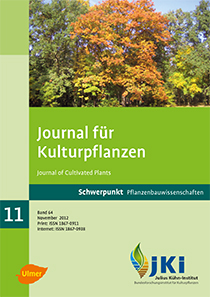Analysis of costs for the use of pesticides in winter wheat and winter oil seed rape based on Network of Reference Farms Plant Protection 2007–2010
DOI:
https://doi.org/10.5073/JfK.2012.11.03Keywords:
Pesticide use, winter wheat, winter oil seed rape, costs, Reference FarmsAbstract
Since 2007, the Network of Reference Farms Plant Protection has been in operation. Its aim is to gather information about the intensity of pesticide use in main crops and regions every year. Minimum need assessments are also carried out by experts from the plant protection services. Based on these findings, economic analyses regarding the pesticide use in the farms were conducted on winter wheat and winter oil seed rape. Altogether, 13 264 single measures on 1457 fields were considered during the period 2007–2010. The data were entered into an Oracle-database and evaluated according to regions and pesticide groups. Additionally, for every plant protection measure, both the product costs and operating costs were determined.
Based on the intensity of the pesticide treatment measured as Treatment Frequency Index (TFI), the average costs of one plant protection measure and the costs of a TFI at 1.0 were determined. Furthermore, the total costs for plant protection measures were calculated. On average for four years, they amounted to 214.40 € for winter wheat and 247.00 € for winter oil seed rape per hectare per year. Finally, the data were evaluated in correlation with several influences. In winter wheat, there were positive correlations between total costs and yield as well as total costs and soil value and a negative correlation between total costs and farm area. In contrast, winter oil seed rape showed positive correlations between total costs and farm area as well as between total costs and field size. In conclusion, the results showed that the costs for plant protection measures in winter oil seed rape were clearly higher than the costs in winter wheat. This resulted mainly from the overall higher TFI and the higher expenditures for herbicides and insecticides in winter oil seed rape.
Downloads
Published
Issue
Section
License
The content of the journal is licensed under the Creative Commons Attribution 4.0 License. Any user is free to share and adapt (remix, transform, build upon) the content as long as the original publication is attributed (authors, title, year, journal, issue, pages).
The copyright of the published work remains with the authors. The authors grant the Journal of Cultivated Plants, the Julius Kühn-Institut and the OpenAgrar repository the non-exclusive right to distribute and exploit the work.







